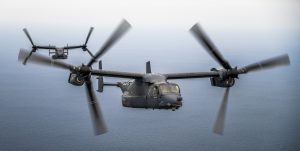In a tragic accident, a Bell Boeing CV-22 Osprey of the U.S. Air Force (USAF) with eight people on board crashed into waters off Kagoshima prefecture in southwestern Japan on November 29. The Japanese Ministry of Defense said on November 30 that one crew member has been confirmed dead and seven others are still missing.
Past deadly crashes involving U.S. military Ospreys have occurred in the United States and elsewhere, but this is the first such fatal crash in Japan. The latest crash raises further questions about the safety of the tiltrotor transport aircraft.
On November 30, following the latest crash, Japanese Defense Minister Kihara Minoru requested Lieutenant General Ricky Rupp, commander of U.S. Forces Japan and the Fifth Air Force, in person to ground Osprey transport aircraft until the U.S. military can confirm they are safe to operate.
In response, the U.S. commander thanked the Japan Self-Defense Forces and others for their search and rescue supports and said, “The safety of Americans and the Japanese people is the top priority for the United States.” However, Rupp did not specifically respond to Japan’s request.
On the Japanese side, the Ground Self-Defense Force decided to suspend its own Osprey flights for the time being.
The USAF Osprey disappeared from radar at around 2:40 p.m. Tokyo time on November 29 off the island of Yakushima, according to Japan’s Defense Ministry.
The Osprey had planned to fly in a formation of three tiltrotor aircraft from the U.S. military base in Iwakuni in Yamaguchi Prefecture, western Japan, to Kadena Air Base on Okinawa, Japan’s southernmost prefecture, according to Japanese defense officials.
In a statement on November 29, the U.S. Air Force Special Operations Command (AFSOC) said the aircraft, originally flying from Yokota Air Base in western Tokyo, was involved in an aircraft mishap while performing a routine training mission off the shore of Yakushima Island. It said the aircraft is assigned to the 353rd Special Operations Wing, an operational unit of the AFSOC, stationed at Kadena Air Base.
“Emergency personnel are on scene conducting search-and-rescue operations,” the AFSOC statement said, adding that the cause of the mishap is currently unknown.
In addition to the Japan Coast Guard (JCG) and local fishery cooperative associations, all three JSDF services and U.S. Forces Japan are currently conducting search operations for the remaining seven crewmembers, with patrol ships and aircraft and ground troops on the coast.
They have spotted many pieces of wreckage from the crashed aircraft in the sea.
On November 29, NHK, Japan’s sole public broadcaster, quoted a Yakushima resident as saying he saw the aircraft suddenly flip over and fall head over heels, with fire coming from one of its two engines, and then an explosion before it fell vertically into the sea.
On the same day, TV Asahi, one of Japan’s major television networks, reported that a Yakushima resident informed Kagoshima Prefectural Police that the Osprey crashed onto the coast near Yakushima Airport with fire coming out of its left engine.
USFJ currently deploys six CV-22 Ospreys at Yokota Air Base and 24 MV-22 Ospreys at U.S. Marine Corps Air Station Futenma on Okinawa. The CV-22 has about 90 percent airframe commonality with the MV-22.
Meanwhile, the JGSDF has deployed 14 MV-22s at Camp Kisarazu so far, with plans to eventually deploy a total of 17 aircraft.
The Osprey was a revolutionary capability when it first flew in 1989. But it is an expensive aircraft that has found few buyers abroad – outside the United States, only Japan operates the aircraft, while others that have shown interest, such as Indonesia and Israel, ultimately decided against it. According to the Ministry of Defense, the cost of each MV-22 is about 10 billion yen ($68 million) per aircraft in the 2018 defense budget. In contrast, CH-47 transport helicopters cost only about 5.5 billion yen per aircraft.
In addition, Ospreys also have a high incidence of serious accidents. In less than two years, there have been four fatal crashes. According to the Ministry of Defense, the Class A flight mishap rate was 6.00 for the CV22 (as of the end of September 2021) and 2.27 for the MV-22 as of the end of September 2022. In contrast, according to Flightfax, an online magazine on aviation safety published by the U.S. Army Combat Readiness Center, the overall Army manned aircraft Class A rate was 1.62 in the current fiscal year.
Class A mishaps occur when there is more than $2 million in damage to the aircraft, the aircraft is destroyed, or its pilot or crew are killed or permanently disabled.
































